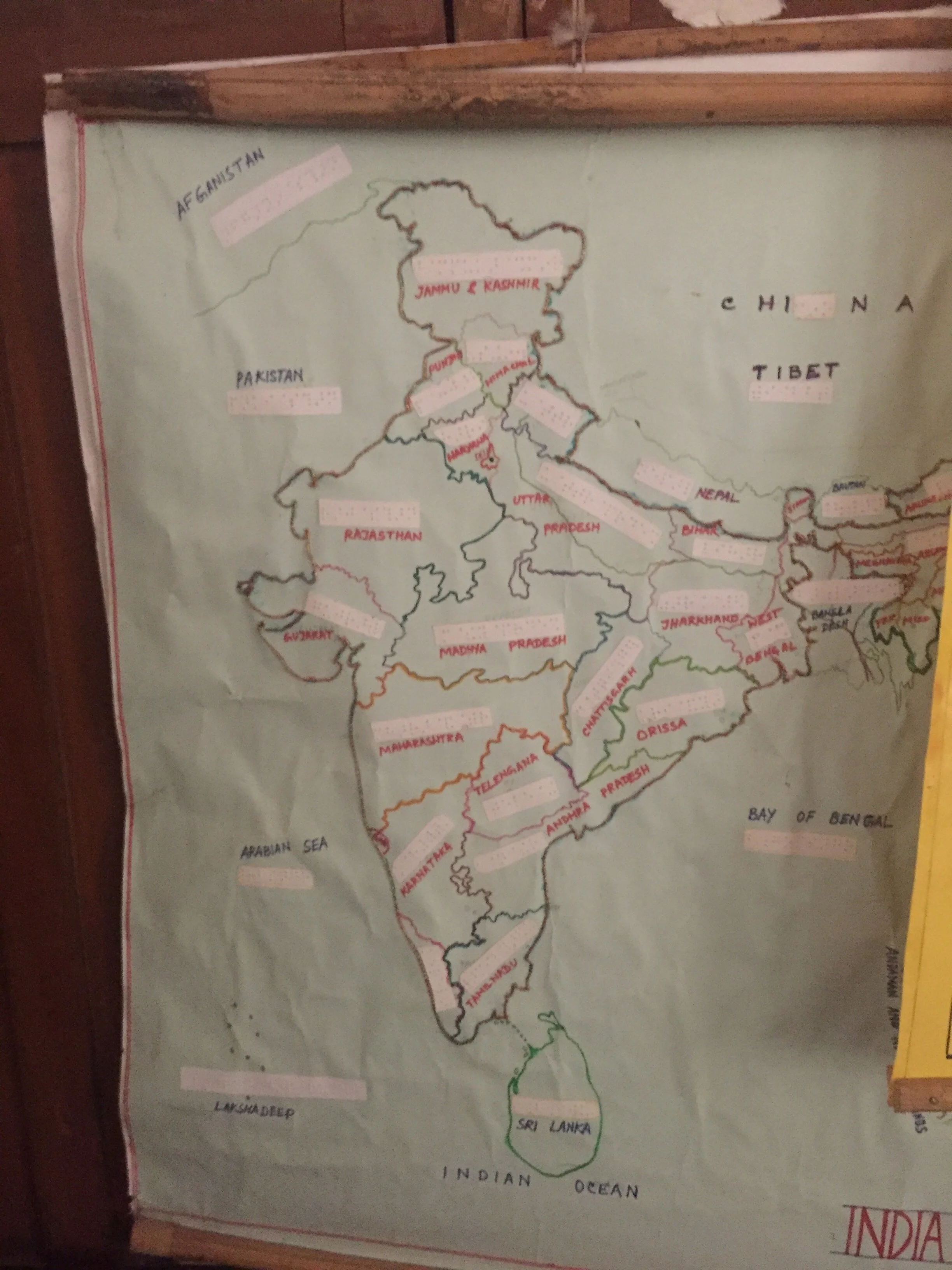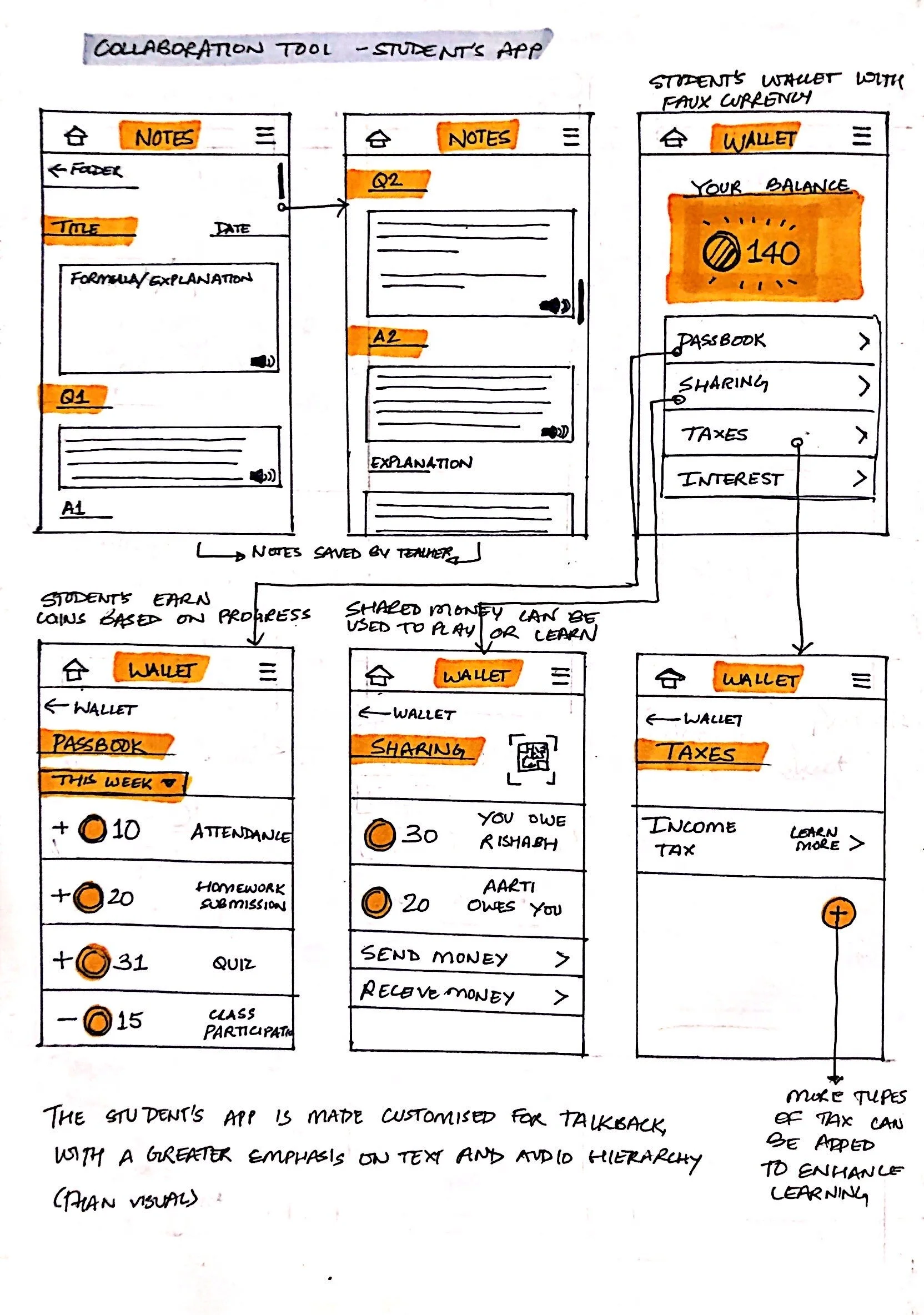
Math Tools for Blind Students
Math Tools for Blind Students
This project was an exploration of the education of high school blind students. It was heavily research driven. My primary motivation was to understand why more blind students don’t pursue higher education in STEM subjects, and to see if intervention could help at a high school level. The result was a set of mathematics tools to be used in a classroom, specifically those which encourage practicing problems and maintaining a record of work.
My Role: Solo Project, Ground Research, Analysis, Conceptualisation
Timeline:
4 months
Deliverables: Sketches, Storyboards, Wireframes, Detailed project report

Quick Overview
After spending 3 full days doing research at a blind school, I conceptualised 4 math tools for blind students. They are all very different in form and function, and try to approach the brief in their own unique way. The idea behind them was to make classroom problem solving quicker and allow recording and revisiting of the work done in class. I drew scenario storyboards to better illustrate the working of each concept.
Digital Taylor Frame and Mobile App
A Modified Electronic Taylor Frame (the tool currently used by blind students to solve problems) and an accompanying mobile app.
Collaborative Learning Tool
A Classroom Collaboration Portal for teachers to assist group work and instruction.
Braille Notebook and Kit
A Slate and Stylus Kit to meet all classroom recording needs.
Taylor Frame Punching Tools
A set of Punching Tools that immortalise the Taylor Frame on paper.
Due to the pandemic, I couldn’t get in touch with the users to test these concepts. You’ll find the pros and cons of each concept as you scroll further. Through these tools, I hope to get the blind students to match the pace of their sighted peers and ultimately achieve the goal of getting blind students to pursue mathematics at higher levels. Keep reading to know how I got here!
Approach
Since the project was exploratory, I began by learning all that I could about the community before deciding on the opportunity area. Research involved reading from literature, watching videos, going through blogs and forums, and finally visiting a blind school and spending time with the students there.

Once I discovered an opportunity area, I started converging towards a specific brief and some concepts to address the issues highlighted in the brief. These concepts cover a broad spectrum of possible solutions.
Learning from Literature

Students at a blind school
02 On Assistive Technology
There is a general lack of affordable sophisticated tech in India. Even with the right tools, several of them have to be used together because they don't function as a set. Students often record audio while simultaneously making notes in class so nothing gets missed out.

Braille Notebooks
04 On Memory and Record Keeping
Unlike their sighted peers, blind students have to rely on their memory a lot - from remembering page numbers to recalling past lectures. Despite that they do need to record classes and notes for their reference. Unlike most theoretical subjects which can be audio recorded, mathematics uses a completely different language that is not distinguishable through voice.
01 On Education for the Blind
Globally, blind children can attend school with their sighted peers in the integrated model or attend a special blind school with other blind children. In both cases there is a need for matching pace with sighted children.

(From TL to BR) Perkins Brailler, Braille Tablet, Refreshable Display and DAISY Player
03 On Learning Tools
Different teachers make different adaptations for their students, through the use of tactile graphics or rubber graph boards. For most theoretical subjects, braille is written using the slate and stylus. For mathematics, students make use of the Taylor Frame to solve problems in class and refer to textbooks and youtube videos to study.

Taylor Frame (T) and Slate & Stylus (B)
Spending time at the Blind School
Most of my learning came from visiting and spending 3 full days with students at the local Guwahati Blind High School. I sat in the students’ lectures (maths, science, economics, english, assamese), spent lunchtime with them and even got to visit their dorms and watch them play cricket. The teachers were very welcoming and even answered some of my queries in their breaks.

Economics Class

Tactile graphics to help understand basic visual concepts

Blind Teachers teach the students Braille

A 9th grade Maths class in action
The interview with the teachers really helped to debunk any myths I had about the lives of blind children. They told me about the difficulties faced by students with acquired blindness as opposed to congenitally blind students. I was able to learn a lot about their habits while making play, their ability to make friends, their usage of computers and smartphones and what the syllabus is like for them.

The students all sit facing each other and the teacher


The Taylor Frame - Tool to solve math problems
The students did seem to rely a lot on their memory. The slate and stylus, a tool they use to write braille on paper, requires them to create depressions in paper and write in mirror image, so upon turning they can feel the text and read its reflection. While most blind users find this convenient, it doesn’t allow them to check what they are writing while in action and this takes a toll on their working memory, especially for maths.
Insights
Although I gained a lot of new knowledge from my visits, there were some key insights that later helped me to formulate the brief:

Opportunity Area
To empathise with a community with special needs, especially when they are accustomed to a certain lifestyle, is a challenge in itself. After a point all my reading and discussions were starting to narrow down in the direction of record keeping and problem solving. For me, the challenge of recording mathematics as a different language from any other was intriguing. This helped me draft the “how might we” statement:

01. The speed of classroom education is faster, and
02. The work done is recorded for future reference and practice”
The idea of making learning and delivery faster helps students cover a wider range of subjects and catch up with their sighted peers - since the reason for slowed learning is more due to a communication barrier and less due to their own cognitive abilities. Recording work helps students to check their own pace and progress, allowing them to improve their skill at the subject and gain confidence.
Benchmarking
During literature review I found that there was not enough work done in this area before. To set a benchmark, I decided to compare the three tools that are widely used across the world right now” The Taylor Frame, The Nemeth Code and the Cranmer Abacus.

An Exercise with a Sighted Child
After the lockdown was announced, I couldn’t step out to conduct user research so I had to improvise. Before ideating on the brief, I took the assistance of a sighted child from the 9th grade. By observing her solve math problems and make a record of them in her notebook, I got some insight on the nuances involved in math record keeping. I was able to find patterns by looking at the math notebooks of 8-10 children in Mumbai.


Key Observations:

01
There are four main parts to any problem - a question, an answer, the process and the “rough work.” There are designated “zones” or sequences for each part. For eg, rough work is generally in a column to the left or right of the main problem.
02
Answers may be highlighted by use of stars or boxes so it is easier for a teacher to check and the students to re-check their problems.
03
The steps that are put down are essential, other minor steps are carried out mentally.
04
For lengthy problems, the student keeps turning the page back to refer to what they wrote earlier.

Ideation
I used the Six Thinking Hats technique to dissect the brief into smaller parts and ideate for each part separately. I made sure to keep my thinking unrestricted by the medium or my own abilities, since the user’s convenience was of the highest priority. After accumulating a basketful of ideas, I began to cluster these ideas together to see if they could solve the brief in its entirety. For this I made use of Michael Michalko’s Thinkpak - a tool that has come to my rescue in the toughest situations.

Ideas (green)

Clusters of Ideas and concepts (pink)

Using the Thinkpak
Each of the concepts was then grown, the minor details worked out along with the user scenarios. Due to lack of access to prototyping tools I decided to sketch all my concepts in as much detail as possible. The details of each concept can be found right at the top of this project :)
Evaluation
Since access to users was not possible during the pandemic, I performed a basic benefit-pitfall evaluation of all the concepts against each other.

Experience and Scope
This project still has a long road ahead. The next step would be testing the concepts with the users, to understand how they can be detailed and made better. Even though it couldn’t be finished properly, working on this project opened my mind to the challenges faced by the visually impaired. I discovered that there is so much more that can be done to make their lives easier. I also learned how to design for accessibility, both in the tangible and digital realm. The period of the project coincided with the COVID-19 lockdown, and this taught me how to work within tight constraints.













